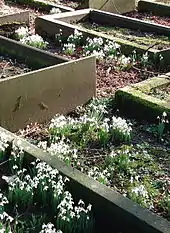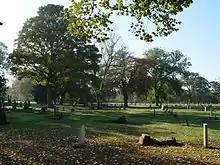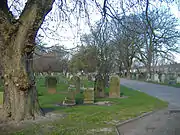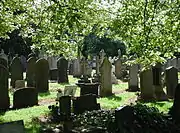Hull General Cemetery
Hull General Cemetery was established by a private company in 1847 on Spring Bank, in the west of Kingston upon Hull, East Riding of Yorkshire, England. In 1862 the Hull Corporation established a cemetery adjacent, now known as Western Cemetery, and in c. 1890 expanded the cemetery west across Chanterlands Avenue onto an adjacent site.

The General Cemetery contains several notable monument and burials, including a monument to a cholera outbreak in 1849, as well as the graves of many notable persons of the Victoria era and early 20th century of Kingston upon Hull. The General Cemetery closed in 1972, the Western Cemetery is, as of 2018, still in use.
In 2018 a community group of volunteers, The Friends of Hull General Cemetery, was formed and have taken on the challenge of caring for this heritage site of special natural interest. The group was formed as a subcommittee of the Hull Civic Society. It meets regularly at the Avenues Centre, Park Avenue, Hull. During its short life it has generated a significant amount of interest in the cemetery from the general public and plans are afoot to bid for local and national funding to make the cemetery a more hospitable place for the community to visit yet still retain its historical significance and environmental importance for future generations.
In September 2018 a short introduction to the Hull General Cemetery 1847 – 1972, was published by Pete Lowden and Bill Longbone[1]
History
Hull General Cemetery

Hull General Cemetery Company was established in 1846,[map 1] with a capital of 1,000 shares of £10. The cemetery on Spring Bank was opened in 1847, for Anglican burials only, with the foundation stone of the cemetery's entrance lodge formally laid by the mayor, B.M. Jalland on 2 June.[note 1] The ground was consecrated on 28 August 1847.[3][4] In 1859 the foundation stone for the cemetery's chapel was laid, by the mayor, Martin Samuelson.[5][map 2] The cemetery entrance was in a gothic revival style,[map 3] consisting of three lodges and six large double gates;[note 2] the original mortuary chapel was octagonal, a second chapel was later added exclusively for Anglican rites, and a third in 1863 for the use of non-conformists.[6][note 3] At the time of its development the cemetery was in the parish of Cottingham, and on the outer fringes of the urban development of Hull.[7][8]
In 1854 an act allowed incorporation of the company, and allowed it to expand.[3][7][note 4] Intramural burial were abolished in Hull after 1856/7.[9] In 1855 Quakers took a 999-year lease on a plot of ground within the cemetery.[map 4] Several prominent Quakers were later buried in the ground including persons from the prominent local employers of the Reckitt, and Priestmann families.[10] By 1864 the cemetery occupied around 20 acres (8.1 ha), and contained over 10,000 interments.[11]
The main gates were demolished in the early 20th century, and built over.[12] The Hull General Cemetery went into receivership in the 1970s,[13][14] and maintenance of the cemetery was taken over by Hull City Council.[15] The final interment was in 1972, excluding the Quaker burial ground which had its last burial in 1974.[10] The overgrown cemetery was cleared after being taken over by the council in 1972.[15] The main gates, and all the chapels had been demolished by 1983.[16]
The Hull General Cemetery Company sought liquidation via the courts which it achieved in 1972 leaving the site without ownership. Eventually, after questions asked in Parliament the site was sold to Hull City Council for a nominal sum of £1 in 1974. At the time the local press was calling the site an ‘eyesore’ and demanding that it was cleaned up. What the aims of the council were when it acquired the land initially is open to question and it could be argued the local authority was reacting to events rather than having a strategic goal for the site.
However, within a short space of time the local authority made clear that the cemetery should be re-developed. There had been earlier demonstrations of cemetery ‘re-development’ in the city when Trippet Street, Division Road and the Drypool graveyards in the early 1960s and 70’s suffered this process. Redevelopment in this sense meant that the vast majority of headstones would be removed and the cemetery landscaped. This took the form of harrowing and grass seeding the ground so that it could be mown.
Public opposition to this plan for Hull General Cemetery, including such names as Philip Larkin and John Betjeman, was overruled and the wholesale destruction of irreparable historical artefacts took place. The whole process took about 18 months. However, because of Hull General Cemetery’s conspicuous role in Victorian Hull, a number of headstones, principally of more notable members of the public, were allowed to remain. Also, as an indication of how ‘bad’ the cemetery had become until the council stepped in, a number of rows of headstones were left in situ. These are the rows next to and surrounding the Quaker plot. By 1979 the site had been ‘developed’.
At first the council maintained the grounds. Grass cutting took place on a regular basis and paths were re-laid every year with sand and gravel. The council maintained the trees. The cemetery resembled a park with headstones dotted around. Children played there, families picnicked and dogs were walked. Apart from the headstones, the cemetery may well have been, to a casual observer, either West Park or Pearson Park.
Unfortunately, over time, with the council suffering significant funding cuts, the maintenance of the cemetery fell by the wayside and it began to acquire a neglected feel. The dumping of rubbish began to happen more regularly, paths became quagmires; sycamore saplings began to destroy the remaining stones whilst ivy swamped them. The entire cemetery was quickly becoming a place to avoid rather than to visit.[17]
With the formation of the Friends of Hull General Cemetery in 2018 unpaid volunteers began to address the neglect of the Cemetery and thoughtfully, carefully and sensitively began to reclaim the cemetery and began encouraging the diversity of flora and wildlife and also to encourage local residents to enjoy the diversity the Cemetery has to offer. As a result the Hull General Cemetery woke from its slumber in 2018 and started to come alive and the undesirables left to leave it an oasis of tranquillity almost in the very heart of the city. The hard work of the Friends of Hull General Cemetery has brought enjoyment and relaxation to so many people ... many of whom have lived near to but avoided the cemetery because of the what it had deteriorated to but now look at it with loving eyes. Wildlife has started to return to the cemetery and The Friends of Hull General Cemetery are mindful to of the need to strike a balance between the needs of the flora and fauna and also the needs of the public to enjoy been able to escape an inner city environment and step into an 'ancient' woodland.
To this end the original objectives of Friends of Hull General Cemetery (to be achieved by working in close consultation with the land owners, Hull City Council) are as follows…
- Landscape and Woodland Management: To employ sustainable, multi-objective woodland management to preserve and improve the important function of the mature, broadleaved woodland on the site in the urban landscape.
- Social History: To conserve the burial monuments and associated features in their woodland setting and to encourage their interpretation and appreciation.
- Education: To encourage the educational use of the area, including its use as a local nature-site and its use to engage the local community in the Hull Biodiversity Action Plan process.
- Access, Recreation and Inclusion: To ensure that the open, public-access to the site is maintained, that it is safe and welcoming to everyone and wherein the formal path network is well managed and accessible to all.
- Biodiversity: To conserve and enhance the flora and fauna at the site, their habitats and diversity, including protected species.
- Community Involvement: To enable the engagement of the local community in the active management of the site.
- Safety and Public Amenity: To ensure the site is maintained in a safe condition and manner.
- Implementation, Funding and Partnerships: To set out a programme of implementation for the practical and administrative management of the proposed project which identifies responsibilities, costs and potential means of funding the management of the site, including possible community and voluntary sector partners to work with the City Council. Community involvement will be central to the development and implementation of the plan.
- Involvement of local businesses: To provide assistance, both financial and practical help with tools, equipment and materials.
- CWGC: Identify, locate and record all Commonwealth War Graves Commission (CWGC) graves within the cemetery.
- Photographic Record Project: Record all of the remaining headstones in the cemetery.
- Litter: Remove litter and fly-tipped material and provide litter bins throughout the cemetery which will be regularly emptied by the volunteers.
- Ivy: Remove ivy and invasive plants from around headstones to prevent damage by same. Care to be taken not to damage stones or interfere with nesting birds.
- Pathways: Tidy and re-establish cemetery pathways, and maintain where possible.[18]
Conclusion
Hull General Cemetery is one of the greatest historical resources that the city of Hull has. That it has been abused, neglected and damaged by its custodians is not in doubt but it still breathes charm and exudes magic. Walking there, within 100 yards of a major thoroughfare, one can forget the modern world.
The Friends of Hull General Cemetery are actively working to create an oasis for the community in the heart of the city. The Friends of Hull General Cemetery Facebook group[19] was formed to promote and celebrate the unique historical and environmental attributes of the cemetery. It is the ‘Friends’ intention to try and turn this long-overgrown and disused burial ground into a place which can once more be enjoyed by all in the local neighbourhood. The 'Friends' hope to achieve this over time by clearing-up the graves and headstones, by encouraging the diversity of flora and wildlife, by promoting historical research, and most importantly of all by getting and keeping local people and organisations involved in its upkeep.
The goals of the 'Friends' could never be achievable without the input of time, energy and ideas by its members and volunteers who throughout the years (and whatever the weather) make themselves available to help in the upkeep and ongoing improvements of the cemetery and its overall environment.
Notable graves and monuments

- Monument to the victims of the 1849 cholera epidemic, erected through private contributions. Around 700 victims were buried in the cemetery.[20][21]
- William Clowes, d.1851, Methodist.[22][23]
- Joseph Beaumont, d.1855, Weslyan preacher.[24]
- Count de Werdinsky, d.1856, supposed displaced Polish nobleman, probable serial fraudster and criminal.[25][26]
- Cast Iron monument in the style of an Eleanor Cross (listed structure, c. 1860s).[27]
- Isaac Reckitt, d.1862, Quaker, founder of Reckitt and Sons.[10]
- Henry Blundell, d.1865, founder of the paint company Blundell Spence and Company.[28]
- Monument to John Gravill, d. c. 1866, captain of the ill-fated whaling ship Diana.[29][30]
- Thomas Wilson, d.1869, shipping magnate.[31]
- Thomas Earle, d.1873, sculptor.[31]
- Henry Redmore, d.1887, artist.[15]
- Monument to John Rylands (d.1888).[32] (buried in Southern Cemetery, Manchester.)
- James Reckitt, d.1922, Quaker, philanthropist, also of Reckitt and Sons.[10]
- William Dent Priestman, d.1936, Quaker, oil engineer pioneer, founder of Priestman Brothers
- Family and wife of Albert Kaye Rollit, mayor of Hull, politician and lawyer.[33]
Hull Western Cemetery

5 acres (2.0 ha) of land had been set aside by the Hull General Cemetery for use of the board of health (1859), and in 1862 the board acquired the land, opening a new cemetery adjacent west of the old General Cemetery, known as the Western Cemetery.[3][15][map 5] A chapel was later added for Anglican rites,[map 6] and a third in 1863 for the use of non-conformists.[map 7][6][note 3] By 1892 the Western Cemetery occupied 27.5 acres (11.1 ha).[34]
In c. 1889 the cemetery was expanded westwards, with additional land on the opposite side of Chanterlands Avenue,[35][map 8] a further mortuary chapel was built in the extension.[map 9] As of 1995 all the cemetery's chapels had been demolished.[16][36]
As of 2018 the Western Cemetery is in still use.[37]
Notable graves and monuments
- A monument to those killed in the R38 Airship disaster over the Humber Estuary.[38]
- Memorials to Captain George Henry Smith, and to William Richard Leggert, both killed in the Dogger Bank incident.[39][40]
- John Cunningham, Victoria Cross recipient, 1916
- The cemetery contains the war graves of 493 Commonwealth service personnel, 393 from the First World War and 100 from the Second World War.
Gallery
.jpg.webp) Gatehouse, Western Cemetery extension (2013)
Gatehouse, Western Cemetery extension (2013).jpg.webp) First World War Cross of Sacrifice memorial, Western Cemetery (2013)
First World War Cross of Sacrifice memorial, Western Cemetery (2013).jpg.webp) Spring Bank entrance gates, General Cemetery (2012)
Spring Bank entrance gates, General Cemetery (2012) Eastern part of the Western Cemetery (2007)
Eastern part of the Western Cemetery (2007) Graves in the western part of the cemetery (2007)
Graves in the western part of the cemetery (2007) R38 memorial, Western Cemetery
R38 memorial, Western Cemetery
Notes
- The lodge was designed by Cuthbert Brodrick.[2]
- The entrance gave the name to the nearby Hull Cemetery Gates railway station (originally 'Hull Cemetery station') on the Victoria Dock Branch Line. After 1881 the station was known as Hull Botanic Gardens.
- Later chapels were added in the "Western Cemetery". Sheahan 1864 makes no distinction between the two, referring to both as "Hull Cemetery". See Ordnance Survey maps from 1850 to 1900.
- 17 & 18th Vic., Cap. 100 (3 July 1854) An Act to incorporate the Hull General Cemetery Company, and to enlarge and improve their cemetery, and for other purposes.
References
- Pete Lowden and Bill Longbone (2018). Hull General Cemetery 1847 – 1972, A Short Introduction. Independently published (9 September 2018). ISBN 1720182663.
- Sheahan 1864, p. 557.
- Allison, K.J., ed. (1969), "Public services – Cemeteries", A History of the County of York East Riding, 1, the City of Kingston Upon Hull
- Sheahan 1864, pp. 557–8.
- Sheahan 1864, p. 558.
- Sheahan 1864, pp. 558–9.
- Notices:
- prior : "Hull General Cemetery Company. Incorporation of Company, Power to Maintain and Enlarge Cemetery in the parish of Cottingham, in the East Riding of the county of York. To Increase Capital, and for other purposes.", London Gazette (21382): 3100–3101, 19 November 1852
- "Hull General Cemetery Company. (Incorporation of Company; Power to maintain and enlarge Cemetery in the parish of Cottingham, in the East Riding of the county of York ; to Increase Capital; to set apart portions of the Cemetery as and for the burial places for such Parishes, Churchea, or Chapels, within the borough, of Kingston-upon-hull, whoso Burial-grounds, Churches, or Chapels, may be closed under the provisions of the Act to Amend the Laws concerning the Burial of the Dead in England beyond the limits of the Metropolis; and for other purposes.)", London Gazette (21494): 3091–3092, 15 November 1853
- Ordnance Survey Sheet 240 1:1560 1853
- Sheahan 1864, p. 556.
- "The Quaker Burial Ground, Spring Bank". EYLHS Newsletter. No. 22. East Yorkshire Local History Society. Winter–Spring 2010. pp. 14–20. Retrieved 17 February 2016.
- Sheahan 1864, p. 559.
- Ordnance Survey 1:2500 1910–11, 1928
- "NOTICE OF APPOINTMENT OF LIQUIDATOR – Name of Company — THE HULL GENERAL CEMETERY COMPANY Limited", London Gazette (45795): 11784, 5 October 1972
- "RELEASE OF LIQUIDATOR – Name of Company—THE HULL GENERAL CEMETERY", London Gazette (48142): 4781, 27 March 1980
- "Spring Bank West Conservation Area Character Statement" (PDF). Hull City Council. 2008. Retrieved 17 February 2016.
- Pevsner & Neave 1995, p. 516.
- "Introduction to the history of Hull General Cemetery". The Friends of Hull General Cemetery.
- "The objectives of 'The Friends of Hull General Cemetery'". Friends of Hull General Cemetery.
- "The Friends of Hull General Cemetery". Facebook : The Friends of Hull General Cemetery.
- Sheahan 1864, p. 177.
- Historic England. "CHOLERA MEMORIAL IN GENERAL CEMETERY (1219374)". National Heritage List for England. Retrieved 17 February 2016.
- Lowe, Mel (11 February 2013). "William Clowes – Grave: Hull General Cemetery". www.myprimitivemethodists.org.uk. Retrieved 17 February 2016.
- Sheahan 1864, p. 432.
- Sheahan 1864, p. 426.
- Symons 1889, p. 130.
- Deighton, Alan (2014), "A Shocking Case of Starvation in Hull" – A Short Memoir of the Life of "Count" Adolph de Werdinsky, Highgate Publications (Beverley) Ltd, ISBN 1902645618
- Historic England. "One of a pair of Gothic iron monuments in General Cemetery situated at TA0804429641 (1197663)". National Heritage List for England. Retrieved 17 February 2016.
- Symons 1889, pp. 127–8.
- Historic England. "MONUMENT TO CAPTAIN JOHN GRAVILL IN GENERAL CEMETERY (1389312)". National Heritage List for England. Retrieved 17 February 2016.
- Symons 1889, pp. 128–9.
- Symons 1889, p. 137.
- Symons 1889, pp. 136–7.
- Symons 1889, pp. 135–6.
- "Hull – Parks, Pier, Cemeteries, Railway Stations", Bulmer's Gazette, 1892
- "Records relating to burials". Hull History Centre. Retrieved 17 February 2016.
- Ordnance Survey 1:25000 2006
- "Burials and cemeteries". Hull City Council. Archived from the original on 11 October 2016. Retrieved 15 July 2018.
- Historic England. "AIRSHIP MEMORIAL (1512866)". PastScape. Retrieved 17 February 2016.
- Historic England. "MEMORIAL TO CAPTAIN GEORGE HENRY SMITH, HULL WESTERN CEMETERY (1392905)". National Heritage List for England. Retrieved 17 February 2016.
- Historic England. "MEMORIAL TO WILLIAM RICHARD LEGGETT, HULL WESTERN CEMETERY (1392906)". National Heritage List for England. Retrieved 17 February 2016.
Sources
- Pevsner, Nikolaus; Neave, David (1995), "Yorkshire: York and the East Riding", The Buildings of England (2 ed.), ISBN 9780300095937
- Sheahan, James Joseph (1864), General and concise history and description of the town and port of Kingston-upon-Hull
- Symons, John (1889), "A Visit to Spring Bank Cemetery", Kingstoniana: being Historical Gleanings and Personal Recollections, pp. 124 –
Landmarks and map locations
- 53.751918°N 0.363632°W , General Cemetery
- 53.752524°N 0.363045°W, General Cemetery mortuary chapel (site of)
- 53.751813°N 0.361377°W, General Cemetery original gate entrance (site of)
- 53.751581°N 0.368344°W, Quaker burial ground
- 53.751718°N 0.370872°W, Western Cemetery
- 53.751454°N 0.374867°W, Western Cemetery, 1890s addition, Mortuary chapel (site of)
- 53.751482°N 0.371570°W, Mortuary chapel, non conformist (site of)
- 53.751761°N 0.376344°W, Western Cemetery, 1890s addition
- 53.751556°N 0.369853°W, Mortuary chapel, C of E (site of)
External links
| Wikimedia Commons has media related to General Cemetery, Kingston upon Hull. |
| Wikimedia Commons has media related to Western Cemetery, Kingston upon Hull. |
